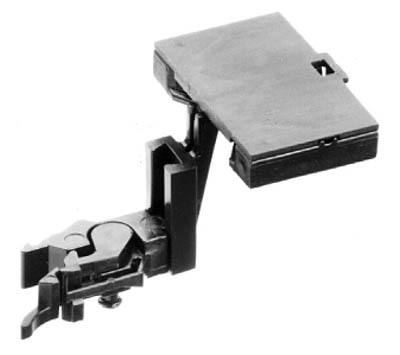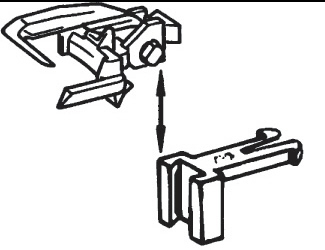(Ab Werk) Schleifer Befestigung bei der Fleischmann BR94. Der braune Plastik stöpsel wird in die plastic Bodenplatte geklipst. Dieser geringert die Bodenfreiheit um etwas 2+ Millimeter was zum hängenbleiben auf Entkupplungsgleisen und holpern über Weichen führt.
OEM attachment of the slider on the Fleischmann BR94. The brown plastic plug clips into the plate at the bottom of the engine. This reduces the ground clearance by a bit over 2 millimeters causing the engine to get hung up on decoupling tracks and bumping when going over some turnouts.

Der Stöpsel (1) wurde raus gezogen um den Schleifer zu entfernen, die Laschen (2) wurden gerade gebogen und dann abgetrennt, und die Platte (3) wurde entfernt. An die Platte (4) ist der Draht für die Stromaufnahme gelötet, ist aber sonst lose.
The plug (1) was pulled out to remove the slider, the bent over tabs (2) were trimmed off, and the plate (3) was removed. The power pickup wire is soldered to the plate (4), but this is not otherwise secured to the engine.
 Der Schleifer wurde dann direkt an die Platte (4) gelötet. Die Platte (3) wurde nicht wieder verwendet. Die Platte (4) wurde dann mit Sekundenkleber auf die Bodenplatte geklebt.
Der Schleifer wurde dann direkt an die Platte (4) gelötet. Die Platte (3) wurde nicht wieder verwendet. Die Platte (4) wurde dann mit Sekundenkleber auf die Bodenplatte geklebt.The slider was then soldered directly to the plate (4). This assembly was then glued to the baseplate of the engine with CA adhesive. Plate (3) was not reused.

Der Schleifer liegt jetzt direkt auf der Bodenplatte der Lok.
The slider now sits directly on the baseplate of the engine.

Durch diesen Umbau bleibt die Lok nicht mehr auf den Entkupplungsgleisen hängen und durchfährt auch alle Weichen viel besser. Nur die 3-wegweiche verursacht noch glegentlich Schwierigkeiten, das aber nur beim links Abbiegen in Rückwärtsfahrt. Hier kann die Lok dann immernoch vom Gleis springen, aber wie im Video gezeigt geht es auch sanft durch.
The engine no longer hangs up on the uncoupler tracks and it makes it through the turnouts much more smoothly. The 3-way switch still causes occasional problems when forking to the left running backwards. Here it still jumps occasionally to derail, but as the video shows it can also go through smoothly.
Higher quality video here at YouTube.










